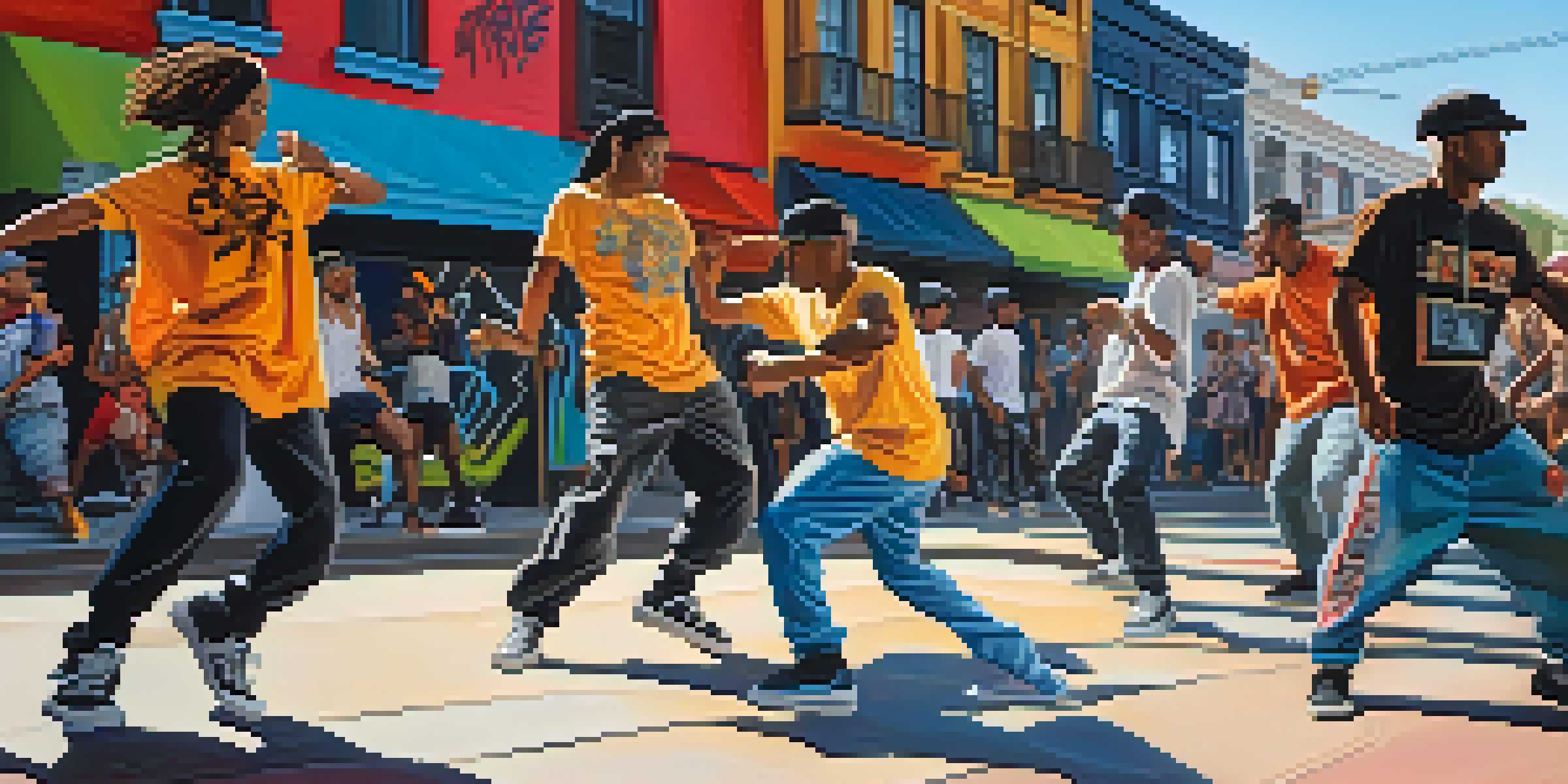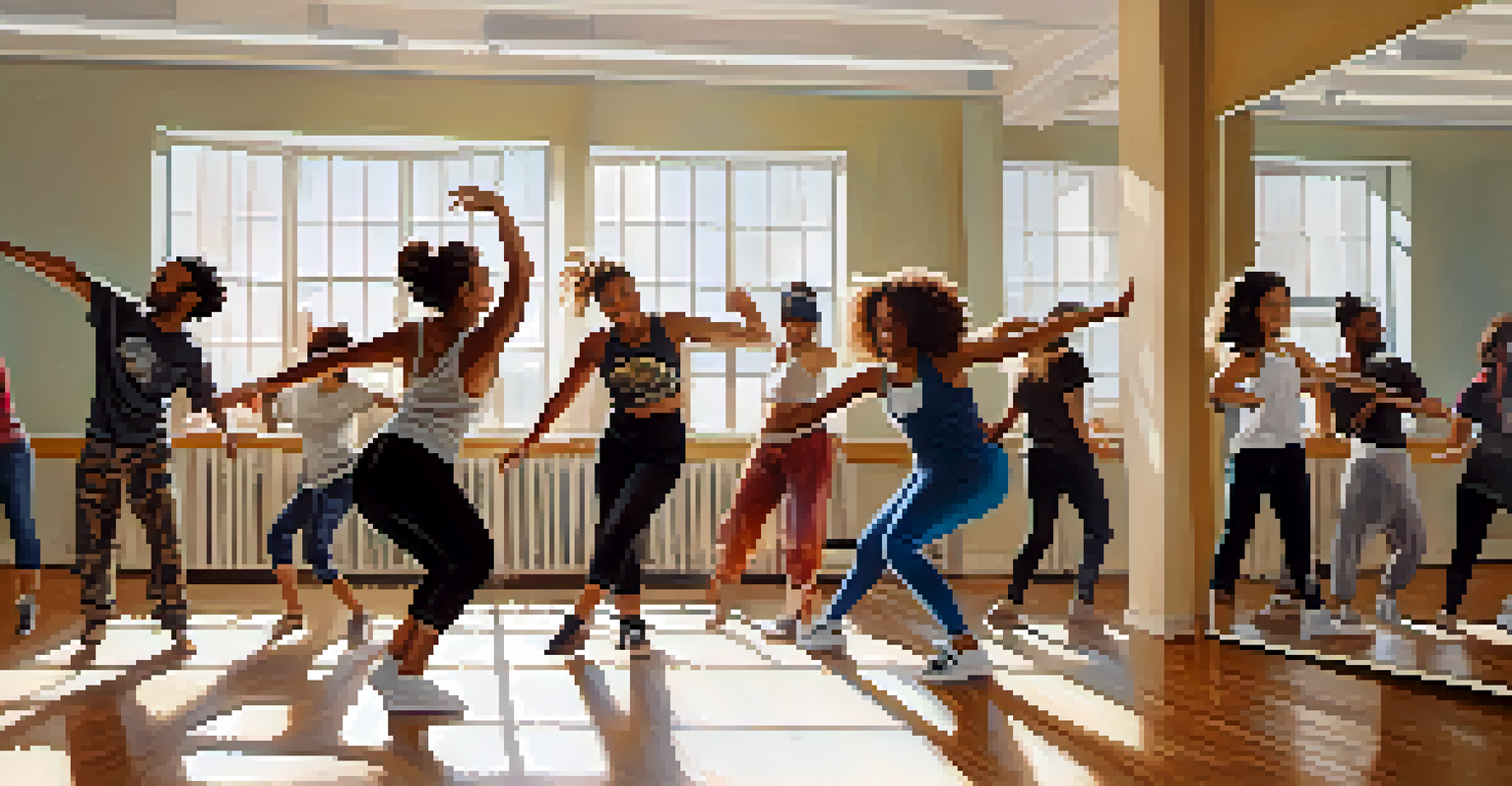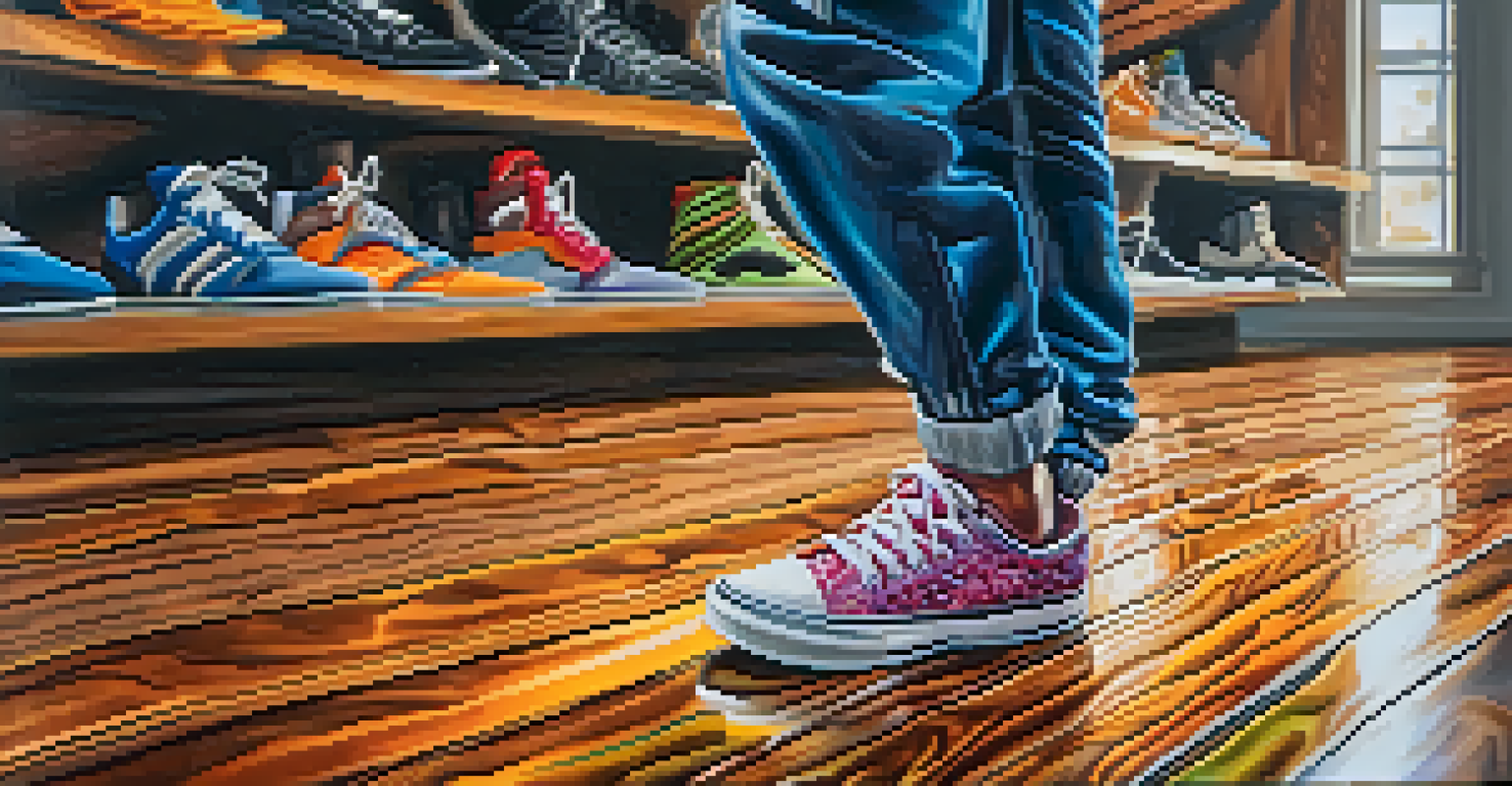The Influence of Hip Hop Dance on Modern Social Interactions

Hip Hop Dance: A Cultural Movement Beyond Movement
Hip hop dance isn't just a series of steps; it's a rich cultural expression that emerged from a blend of artistic influences. Originating in the 1970s, it has roots in African American and Latino communities, reflecting their stories and experiences. Through its energetic movements and unique styles, hip hop dance serves as a form of storytelling that resonates with many.
Dance is the hidden language of the soul.
This dance form has evolved over the decades, but its core message of self-expression remains intact. It challenges societal norms and encourages individuals to embrace their identities. As hip hop continues to grow, it influences everything from fashion to music, creating a vibrant tapestry of cultural interactions.
In today's society, hip hop dance acts as a bridge connecting diverse communities. It transcends geographical boundaries, allowing people from various backgrounds to come together, share experiences, and celebrate their differences. This cultural exchange fosters understanding and respect, making hip hop dance a powerful tool for social interaction.
The Role of Social Media in Hip Hop Dance Popularity
Social media platforms like TikTok and Instagram have revolutionized how hip hop dance is shared and experienced. Dancers can showcase their skills in short clips, reaching audiences far beyond their local communities. This instant visibility helps to democratize dance, allowing anyone with a smartphone to participate in the conversation.

These platforms have also given rise to viral dance challenges that encourage engagement and participation. When a popular dance moves across social media, it creates a shared experience for users, fostering connections even among strangers. As people replicate and share these dances, they bond over a common interest, reinforcing social ties.
Hip Hop Dance as Cultural Expression
Hip hop dance transcends mere movement, serving as a powerful form of storytelling that reflects the identities and experiences of diverse communities.
Moreover, social media enables dancers to collaborate remotely, breaking down geographical barriers. This global interconnectedness allows for the blending of styles and influences, leading to innovative dance trends. As a result, hip hop dance continues to evolve, fueled by the collaborative spirit of the online community.
Hip Hop Dance as a Tool for Social Change
Hip hop dance often serves as a means of activism, raising awareness about social issues and injustices. Dancers use their art to highlight topics such as racism, poverty, and inequality, making powerful statements that resonate with audiences. This ability to convey important messages through movement can inspire change and encourage dialogue.
Hip hop is a vehicle for social change and a voice for those who feel unheard.
Many dance groups and organizations leverage hip hop to empower marginalized communities. By providing opportunities for self-expression and creativity, they foster a sense of belonging and purpose. This empowerment can lead to increased confidence, helping individuals to take a stand for their rights and advocate for social change.
Moreover, hip hop dance events often serve as platforms for community building and engagement. These gatherings create spaces where individuals can connect, share their experiences, and support one another. In this way, hip hop dance not only entertains but also cultivates a sense of unity and strength among participants.
The Connection Between Hip Hop Dance and Identity
For many, hip hop dance is a powerful expression of personal and cultural identity. It allows individuals to explore their roots and showcase their unique backgrounds through movement. This connection to identity is especially significant for marginalized groups seeking to assert their place in a society where they may feel overlooked.
As dancers embrace hip hop culture, they often find a sense of belonging. This shared experience fosters connections among dancers, creating a supportive community that celebrates diversity. By participating in hip hop dance, individuals can express their stories, struggles, and triumphs, enriching the overall cultural landscape.
Social Media Boosts Dance Popularity
Platforms like TikTok and Instagram have democratized hip hop dance, allowing dancers to share their skills and engage with a global audience.
Additionally, the dance form encourages individuals to redefine their identities in a dynamic way. As hip hop evolves, so too do the dancers who engage with it. This fluidity allows for continuous self-discovery, helping dancers to forge connections with both their past and their evolving selves.
Hip Hop Dance and Intergenerational Connections
Hip hop dance has a unique ability to bridge generational gaps, bringing together people of all ages. Older generations often share their experiences and wisdom, while younger dancers introduce fresh perspectives and innovative styles. This exchange of knowledge fosters respect and understanding among different age groups.
Community dance classes and workshops often see participants from various generations coming together to learn and share. These interactions help to break down stereotypes and encourage collaboration, creating a sense of unity. As participants dance side by side, they build lasting relationships based on mutual appreciation and passion for the art form.
Moreover, hip hop's evolution means that each generation adds its own flavor to the dance. Older dancers may teach classic moves, while younger ones introduce contemporary styles. This blending of influences creates a rich dance culture that celebrates both tradition and innovation, strengthening social bonds across generations.
The Impact of Hip Hop Dance on Mental Health and Wellbeing
Engaging in hip hop dance can significantly boost mental health and wellbeing. The physical activity involved releases endorphins, promoting feelings of happiness and reducing stress. For many, dance becomes a form of therapy, allowing them to express emotions that may be difficult to articulate verbally.
Additionally, the social aspect of hip hop dance creates a supportive environment where individuals can connect with others. These connections can combat feelings of loneliness and isolation, fostering a sense of belonging. As dancers come together, they share not only their love for dance but also their challenges, creating a community of support.
Dance Promotes Social Change
Hip hop dance acts as a tool for activism, raising awareness about social issues and empowering marginalized communities through self-expression.
Moreover, the empowerment that comes from mastering new dance skills can enhance self-esteem and confidence. As individuals set and achieve goals within their dance practice, they develop a sense of accomplishment that spills over into other areas of their lives. This positive feedback loop encourages continued engagement, reinforcing the mental health benefits of hip hop dance.
The Future of Hip Hop Dance in Social Interactions
As hip hop dance continues to evolve, its influence on social interactions will likely grow. With the rise of global connectivity, we can expect new styles and collaborations that transcend borders. This evolution will create even more opportunities for individuals to connect through shared experiences and cultural exchange.
Moreover, the increasing recognition of hip hop dance in mainstream media will further elevate its status as a powerful form of expression. As it gains more visibility, more people will be inspired to participate, fostering a larger, more diverse community. This inclusivity will enhance the social fabric, creating a vibrant space for dialogue and creativity.

Ultimately, the future of hip hop dance is bright, with endless possibilities for connection and collaboration. As it continues to inspire and engage, hip hop dance will remain a vital force in shaping modern social interactions, uniting individuals from all walks of life through the universal language of movement.